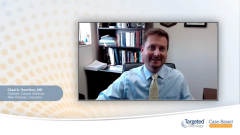
Considerations for Initiating Maintenance Therapy in Ovarian Cancer
An overview of factors that influence the initiation of maintenance therapy for patients with ovarian cancer.
Episodes in this series

Case: A 49-Year-Old Woman with BRCA-WT Ovarian Cancer
- A 49-year-old presented to her primary care physician complaining of abdominal bloating and nausea
- PMH: mild HTN
- FH: mother died of breast cancer at age 59; cousin on mother’s side died of ovarian cancer at age 65
- Imaging: CT reveals small-volume ascites, bilateral 8-cm adnexal masses
- Labs: CA 125, 285 U/mL
- Surgical intervention: she underwent exploratory laparotomy followed by omentectomy, bilateral salpingo-oophorectomy, and resection of peritoneal nodules; optimal cytoreduction with < 1 cm of residual disease after surgery
- Diagnosis: stage IIIC HGSC
- Treatment: She was treated with IV carboplatin and paclitaxel w/ NK1, 5HT3, and dexamethasone CINV prophylaxis
- TRAEs: She experienced persistent daily nausea with vomiting on day 1 after chemotherapy
- Follow-up: After completion of chemotherapy, CA 125, 14.2; clinically NED; patient reports continuing daily nausea
Transcript:
Chad A. Hamilton, MD: I’ve tried to make it a habit to introduce the concept of maintenance therapy and potentially PARP inhibition early on in the treatment course, when patients are receiving their initial cytotoxic chemotherapy with carboplatin and paclitaxel plus minus bevacizumab, so that it’s not a shock to them when we reach the end of those 6 cycles of treatment. And then we were talking about maintenance treatment for either a period of several months to potentially a couple or 3 years. Again, to make it easy on myself with regard to when to start maintenance therapy, I try to be as by the book as I can. In [the phase 3] PAOLA-1 [trial (NCT02477644)], patients had to be at least 3 weeks out from their primary chemotherapy but no more than 9 weeks after the last dose of chemotherapy with all toxicities either resolved or grade 1. I think in [the phase 3] SOLO-1 [trial (NCT01844986)], that may have been an 8-week boundary to start the PARP inhibitor. And in [the phase 3] PRIMA [trial [NCT02655016)], that was stretched up to about 12 weeks for starting after completion of chemotherapy.
In summary, I’m thinking of starting somewhere [from] 1 to at the latest 3 months after chemotherapy with the PARP inhibition. For practical purposes, I’ll usually wait a month and think about starting, but I’m certainly willing to push that timeline out if there are lingering toxicities that the patient is experiencing from up-front therapy. I found the best way to fail at getting a patient to stay with a PARP inhibitor is to start them too soon when they still have some residual bad feelings, toxicity, nausea, or what have you from their frontline therapy and then piling on that potential PARP inhibition toxicity, which we know usually is worse during the first 2 or 3 months of initiation of treatment.
Transcript is AI-generated and edited for clarity and readability.








































